哈佛分析框架与企业财务分析外文文献翻译
基于哈佛分析框架下的企业财务分析
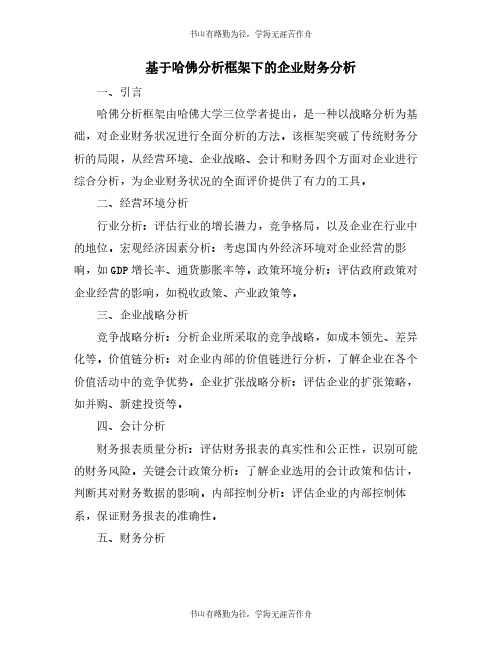
基于哈佛分析框架下的企业财务分析一、引言哈佛分析框架由哈佛大学三位学者提出,是一种以战略分析为基础,对企业财务状况进行全面分析的方法。
该框架突破了传统财务分析的局限,从经营环境、企业战略、会计和财务四个方面对企业进行综合分析,为企业财务状况的全面评价提供了有力的工具。
二、经营环境分析行业分析:评估行业的增长潜力,竞争格局,以及企业在行业中的地位。
宏观经济因素分析:考虑国内外经济环境对企业经营的影响,如GDP增长率、通货膨胀率等。
政策环境分析:评估政府政策对企业经营的影响,如税收政策、产业政策等。
三、企业战略分析竞争战略分析:分析企业所采取的竞争战略,如成本领先、差异化等。
价值链分析:对企业内部的价值链进行分析,了解企业在各个价值活动中的竞争优势。
企业扩张战略分析:评估企业的扩张策略,如并购、新建投资等。
四、会计分析财务报表质量分析:评估财务报表的真实性和公正性,识别可能的财务风险。
关键会计政策分析:了解企业选用的会计政策和估计,判断其对财务数据的影响。
内部控制分析:评估企业的内部控制体系,保证财务报表的准确性。
五、财务分析财务比率分析:利用财务比率,如偿债能力、营运能力、盈利能力等指标,评价企业的财务状况。
现金流分析:通过现金流状况,了解企业的经营状况和偿债能力。
资本结构分析:评估企业的负债结构和权益结构,判断其合理性。
六、前景预测预测主要财务指标:预测企业未来的盈利能力、增长率和现金流状况。
敏感性分析:评估关键因素变动对主要财务指标的影响。
情景分析:根据不同的情景,对企业未来的发展进行预测。
七、结论与建议根据上述分析,对企业财务状况进行总体评价,并提出相应的建议。
哈佛分析框架下A公司财务分析及问题对策研究
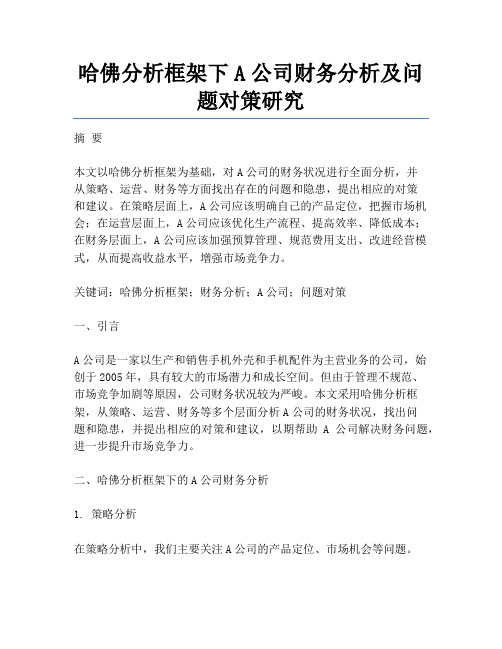
哈佛分析框架下A公司财务分析及问题对策研究摘要本文以哈佛分析框架为基础,对A公司的财务状况进行全面分析,并从策略、运营、财务等方面找出存在的问题和隐患,提出相应的对策和建议。
在策略层面上,A公司应该明确自己的产品定位,把握市场机会;在运营层面上,A公司应该优化生产流程、提高效率、降低成本;在财务层面上,A公司应该加强预算管理、规范费用支出、改进经营模式,从而提高收益水平,增强市场竞争力。
关键词:哈佛分析框架;财务分析;A公司;问题对策一、引言A公司是一家以生产和销售手机外壳和手机配件为主营业务的公司,始创于2005年,具有较大的市场潜力和成长空间。
但由于管理不规范、市场竞争加剧等原因,公司财务状况较为严峻。
本文采用哈佛分析框架,从策略、运营、财务等多个层面分析A公司的财务状况,找出问题和隐患,并提出相应的对策和建议,以期帮助A公司解决财务问题,进一步提升市场竞争力。
二、哈佛分析框架下的A公司财务分析1. 策略分析在策略分析中,我们主要关注A公司的产品定位、市场机会等问题。
(1)产品定位不明确A公司的产品线较为单一,主要生产和销售手机外壳和手机配件。
但是,市场上同类产品竞争激烈,价格战较为严重,因此,公司如果想要长期发展,必须根据市场需求,明确产品定位,提高产品品质,开展差异化经营。
(2)市场机会未被充分把握随着移动互联网的快速发展,手机市场呈快速增长趋势。
A公司应该利用这一机会,加大研发投入,开发新产品,进一步扩大市场份额。
2. 运营分析在运营分析中,我们主要关注公司的生产流程、效率以及成本等问题。
(1)生产流程不完善A公司生产流程较为简单,而且有些员工对生产流程的理解不够透彻,导致生产效率和生产质量受到影响。
(2)效率低下A公司在生产过程中没有完全利用先进设备和技术手段,导致生产效率偏低,且通过手工生产的产品质量不够稳定。
(3)成本偏高公司在生产过程中存在浪费现象,有些物料的损耗过大,人工成本也较高,导致成本居高不下。
哈佛分析框架 外文文献及翻译
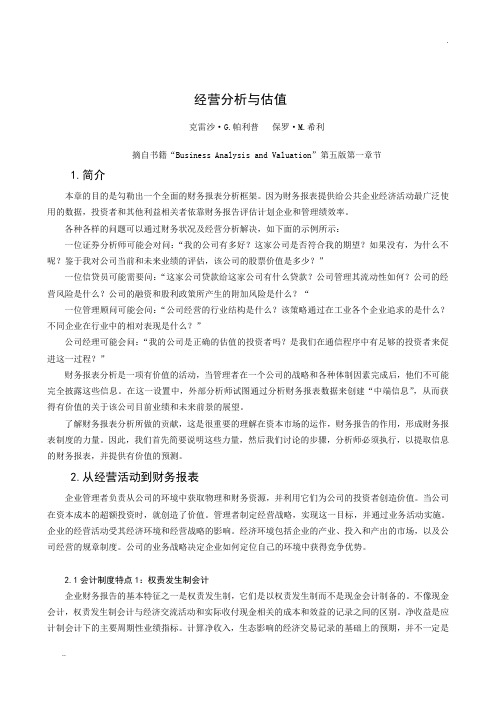
经营分析与估值克雷沙·G.帕利普保罗·M.希利摘自书籍“Business Analysis and Valuation”第五版第一章节1.简介本章的目的是勾勒出一个全面的财务报表分析框架。
因为财务报表提供给公共企业经济活动最广泛使用的数据,投资者和其他利益相关者依靠财务报告评估计划企业和管理绩效率。
各种各样的问题可以通过财务状况及经营分析解决,如下面的示例所示:一位证券分析师可能会对问:“我的公司有多好?这家公司是否符合我的期望?如果没有,为什么不呢?鉴于我对公司当前和未来业绩的评估,该公司的股票价值是多少?”一位信贷员可能需要问:“这家公司贷款给这家公司有什么贷款?公司管理其流动性如何?公司的经营风险是什么?公司的融资和股利政策所产生的附加风险是什么?“一位管理顾问可能会问:“公司经营的行业结构是什么?该策略通过在工业各个企业追求的是什么?不同企业在行业中的相对表现是什么?”公司经理可能会问:“我的公司是正确的估值的投资者吗?是我们在通信程序中有足够的投资者来促进这一过程?”财务报表分析是一项有价值的活动,当管理者在一个公司的战略和各种体制因素完成后,他们不可能完全披露这些信息。
在这一设置中,外部分析师试图通过分析财务报表数据来创建“中端信息”,从而获得有价值的关于该公司目前业绩和未来前景的展望。
了解财务报表分析所做的贡献,这是很重要的理解在资本市场的运作,财务报告的作用,形成财务报表制度的力量。
因此,我们首先简要说明这些力量,然后我们讨论的步骤,分析师必须执行,以提取信息的财务报表,并提供有价值的预测。
2.从经营活动到财务报表企业管理者负责从公司的环境中获取物理和财务资源,并利用它们为公司的投资者创造价值。
当公司在资本成本的超额投资时,就创造了价值。
管理者制定经营战略,实现这一目标,并通过业务活动实施。
企业的经营活动受其经济环境和经营战略的影响。
经济环境包括企业的产业、投入和产出的市场,以及公司经营的规章制度。
《基于哈佛分析框架下的A公司财务分析研究》

《基于哈佛分析框架下的A公司财务分析研究》一、引言在当今竞争激烈的市场环境中,对公司的财务状况进行深入分析对于投资者、债权人、潜在投资者以及管理层来说都至关重要。
本文将基于哈佛分析框架,对A公司的财务状况进行全面、深入的分析。
哈佛分析框架结合了财务分析、战略分析和估值分析,能够更全面地反映公司的整体状况。
二、财务分析1. 资产负债表分析A公司的资产负债表显示,公司资产规模稳步增长,流动资产与非流动资产比例合理。
负债方面,公司负债结构健康,无重大财务风险。
总体来看,A公司的资产负债表状况良好。
2. 利润表分析A公司的利润表显示,公司营业收入和净利润均保持稳定增长,毛利率和净利率处于行业合理水平。
此外,公司成本控制得当,费用结构合理。
3. 现金流量表分析A公司的现金流量表显示,公司经营活动产生的现金流量稳定,投资活动产生的现金流量波动较大,但总体上未对公司的现金流产生负面影响。
此外,公司的筹资活动产生的现金流量也较为稳定。
三、战略分析1. 行业分析A公司所处行业具有较高的竞争性,但行业整体呈增长趋势。
政策环境、技术环境以及社会环境等因素对行业的影响较大。
A 公司在行业中具有一定的竞争优势和市场份额。
2. 公司竞争地位分析A公司在行业中具有一定的品牌影响力和市场地位,产品和服务质量得到了消费者的认可。
此外,公司的销售渠道和营销策略也较为成功,为公司带来了稳定的收入。
四、估值分析1. 市盈率法通过市盈率法对A公司进行估值,需要确定公司的市盈率以及预测未来的收益。
根据公司历史数据和行业数据,可以得出一个合理的市盈率,进而对公司的市值进行估算。
2. 折现现金流法折现现金流法是一种更为精确的估值方法。
通过对公司未来现金流的预测以及风险调整,可以得出公司的内在价值。
这种方法需要更为详细和准确的数据支持。
五、结论与建议通过对A公司基于哈佛分析框架的财务分析研究,我们可以得出以下结论:A公司财务状况良好,资产负债表、利润表和现金流量表均表现稳健;公司在行业中具有一定的竞争优势和市场地位;估值方面,公司市值与内在价值基本相符。
哈佛分析框架下的A公司财务分析
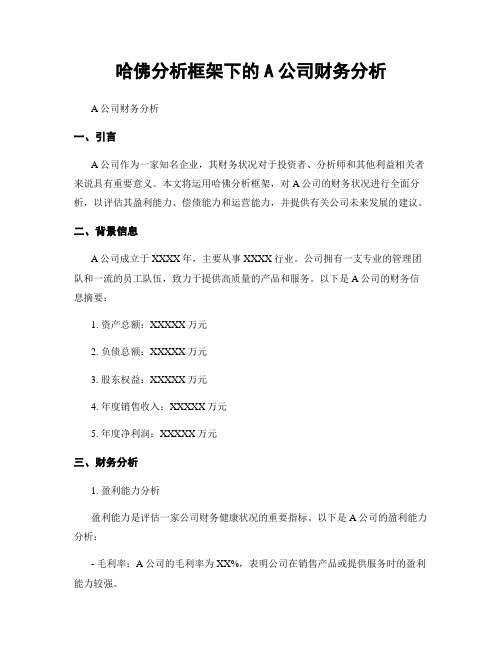
哈佛分析框架下的A公司财务分析A公司财务分析一、引言A公司作为一家知名企业,其财务状况对于投资者、分析师和其他利益相关者来说具有重要意义。
本文将运用哈佛分析框架,对A公司的财务状况进行全面分析,以评估其盈利能力、偿债能力和运营能力,并提供有关公司未来发展的建议。
二、背景信息A公司成立于XXXX年,主要从事XXXX行业。
公司拥有一支专业的管理团队和一流的员工队伍,致力于提供高质量的产品和服务。
以下是A公司的财务信息摘要:1. 资产总额:XXXXX万元2. 负债总额:XXXXX万元3. 股东权益:XXXXX万元4. 年度销售收入:XXXXX万元5. 年度净利润:XXXXX万元三、财务分析1. 盈利能力分析盈利能力是评估一家公司财务健康状况的重要指标。
以下是A公司的盈利能力分析:- 毛利率:A公司的毛利率为XX%,表明公司在销售产品或提供服务时的盈利能力较强。
- 净利率:A公司的净利率为XX%,表明公司在扣除所有费用后实现的净利润占销售收入的比例较高。
- ROE(净资产收益率):A公司的ROE为XX%,表明公司利用股东权益实现的净利润的能力较强。
- ROA(总资产回报率):A公司的ROA为XX%,表明公司利用所有资产实现的净利润的能力较强。
2. 偿债能力分析偿债能力是评估一家公司偿还债务能力的重要指标。
以下是A公司的偿债能力分析:- 流动比率:A公司的流动比率为X,表明公司有足够的流动资金来偿还短期债务。
- 速动比率:A公司的速动比率为X,表明公司在不考虑存货的情况下有足够的流动资金来偿还短期债务。
- 资产负债率:A公司的资产负债率为X%,表明公司资产中被债务占用的比例较低。
3. 运营能力分析运营能力是评估一家公司管理和利用资源的能力的重要指标。
以下是A公司的运营能力分析:- 库存周转率:A公司的库存周转率为X次/年,表明公司有效地管理和利用了库存。
- 应收账款周转率:A公司的应收账款周转率为X次/年,表明公司有效地收回了应收账款。
财务分析的哈佛框架
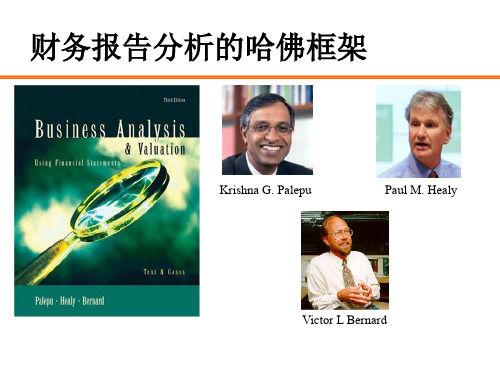
Krishna G. Palepu
Paul M. Healy
Victor L Bernard
战略分析(Strategy Analysis):战略分析是财务报告分 析的重要起点。战略分析为后续的会计分析与财务分析打 下基础。战略分析可以使企业认知利润动因与经营风险。
会计分析(Accounting Analysis):评估企业的会计数据 反映经营业务的程度。评价会计政策和会计估计是否合理, 判断企业会计数字的扭曲程度。
会计分析Strategy Analysis
会计分析的目的
• 评估企业的会计数据反映经营业务的程度。评价 会计政策和会计估计是否合理,判断企业会计数 字的扭曲程度。
• 合理的会计分析能提高财务分析的可靠性。
华天酒店案例分析
华天酒店基本情况
• 1988年5月8日开业,1996年8月8日深交所上市。 • 1995年成立华天国际酒店管理公司,开始酒店集
团化连锁发展,目前已拥有连锁店18家,成为中 南地区最早具备输出品牌管理的酒店。 • 近几年来,已实现由湖南省内城市向全国中心城 市发展的战略转移,在北京、武汉等地托管几家 酒店。
战略分析
“为实现酒店业的可持续发展,必须进行资源整合使 酒店旅游业向深度和广度发展。由此,本公司确立“建 立以酒店为中心的资源整合产业链”的发展战略,实现 上游的餐饮食品、原材料供应、下游的旅行目的地建设 和上中下结合的“酒店+房地产物业建设”的整合,力 争在2010 年发展成为资产达百亿的酒店集团”。
财务分析(Financial Analysis):利用财务数据评估企业 当前和过去的业绩表现及其持续性Байду номын сангаас主要是财务指标分析。
《基于哈佛分析框架的H公司财务分析研究》

《基于哈佛分析框架的H公司财务分析研究》一、引言在当今竞争激烈的市场环境中,财务分析是投资者、分析师以及企业管理者做出决策的重要依据。
本文以H公司为例,运用哈佛分析框架进行财务分析研究。
哈佛分析框架将财务分析与其他战略、前景、行业及市场环境分析相结合,有助于全面、深入地了解公司的财务状况、经营成果和未来发展潜力。
二、财务报表分析(一)资产负债表分析H公司的资产负债表显示,公司资产规模稳步增长,流动资产与非流动资产比例合理。
其中,应收账款、存货等流动资产占比较大,反映出公司较强的运营能力和资金周转速度。
负债方面,公司负债结构健康,主要以流动负债为主,长期负债占比较低,表明公司短期偿债能力较强。
(二)利润表分析利润表显示,H公司营业收入和净利润呈现持续增长态势,毛利率和净利率稳定。
公司成本控制得当,费用支出合理,反映出公司的盈利能力和经营管理水平。
(三)现金流量表分析现金流量表表明,H公司经营活动现金流入稳定,投资活动现金流出主要用于扩张和研发,筹资活动现金流主要用于补充资本。
公司现金及现金等价物储备充足,为未来发展提供了资金保障。
三、比率分析(一)盈利能力指标H公司的盈利能力指标如ROE、ROA、毛利率等均处于行业领先水平,表明公司具有较强的盈利能力和较好的资产运用效率。
(二)运营能力指标运营能力指标如存货周转率、应收账款周转率等表现良好,反映出公司较高的运营效率和良好的资产管理能力。
(三)偿债能力指标偿债能力指标如流动比率、速动比率等保持在安全范围内,表明公司具有较好的短期和长期偿债能力。
四、战略分析(一)行业地位H公司在行业中具有较高的市场份额和较强的竞争力,其产品和服务在市场上具有一定的品牌影响力和用户黏性。
(二)竞争优势H公司的竞争优势主要体现在技术、品牌、营销、渠道等方面。
公司拥有强大的研发团队和先进的技术水平,产品不断创新,保持了市场领先地位。
同时,公司品牌影响力强,营销和渠道策略得当,使得公司产品能够迅速占领市场。
哈佛分析框架与企业财务分析外文文献翻译
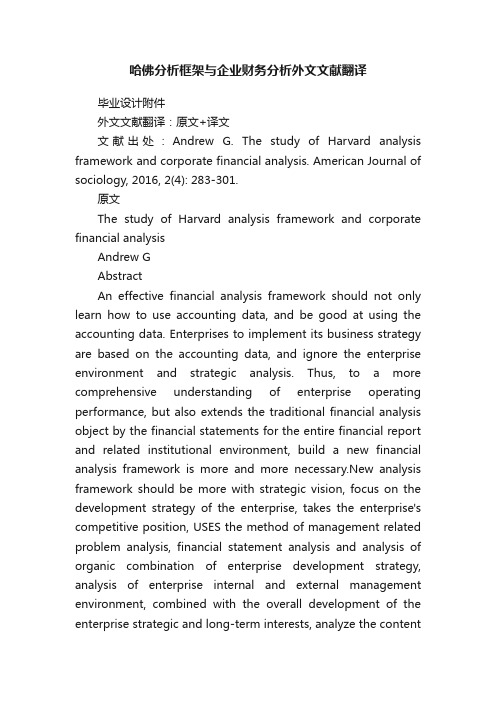
哈佛分析框架与企业财务分析外文文献翻译毕业设计附件外文文献翻译:原文+译文文献出处:Andrew G. The study of Harvard analysis framework and corporate financial analysis. American Journal of sociology, 2016, 2(4): 283-301.原文The study of Harvard analysis framework and corporate financial analysisAndrew GAbstractAn effective financial analysis framework should not only learn how to use accounting data, and be good at using the accounting data. Enterprises to implement its business strategy are based on the accounting data, and ignore the enterprise environment and strategic analysis. Thus, to a more comprehensive understanding of enterprise operating performance, but also extends the traditional financial analysis object by the financial statements for the entire financial report and related institutional environment, build a new financial analysis framework is more and more necessary.New analysis framework should be more with strategic vision, focus on the development strategy of the enterprise, takes the enterprise's competitive position, USES the method of management related problem analysis, financial statement analysis and analysis of organic combination of enterprise development strategy, analysis of enterprise internal and external management environment, combined with the overall development of the enterprise strategic and long-term interests, analyze the contentof the more widely and more wide, to the enterprise management decision making will be more valuable. Harvard analysis framework and harvard analysis framework arises at the historic moment, standing in a strategic point of view, is not limited to the company's financial statements, to analyze the opportunities and threats from external environment, and the enterprise internal strengths and weaknesses, the analysis of financial situation improved prediction is scientific, pointed out the direction of future development for the enterprise.Keywords: Harvard analysis framework, the electric power enterprise, strategy, financial analysis1 IntroductionThe development needs of an enterprise financial analysis for its help, financial analysis has attracted the attention of the enterprise, experts and scholars are also constantly explore the solution to the financial analysis, financial analysis framework of research in recent years, more and more. Harvard analysis is the sublimation of traditional financial analysis, the framework from the management strategy of enterprises, analyzes the financial data of the enterprise, accounting analysis, find out enterprise possible false results, and then adopt some methods to improve the quality of accounting information, and on the basis of financial analysis, realistic analysis of the results, and then forecast the prospect of the enterprise. The traditional financial analysis framework is in the long-term practice of financial analysis and theoretical summary and form, it is main analysis object with financial statements, although joined the financial comprehensive analysis model or system, but still with quantitative analysis as the basic characteristics of neglect or some important financial information cannot be effectivelyincorporated into the analysis framework. Traditional analysis framework is mainly analysis enterprise's financial statements, is basically a state of "report on report". And commonly used analysis methods mainly include ratio analysis, comparative analysis, trend analysis and DuPont financial analysis system, etc., mainly through the calculation and comparison of the financial statement data, draw the corresponding index data, then the results of comparative analysis and factor analysis, heavy "quantity" is not "quality", the lack of the nature of the analysis of a problem. Traditional analysis, with emphasis on the internal situation, the main process flows of the enterprise, asset utilization ability, debt paying ability, profitability analysis, and ignore the external business environment. And analysis based on financial statements and financial statements is a summary of the business in the past, and this analysis has the obvious lag. The traditional financial analysis framework to analyze the data on the enterprise accounting statements cannot havesatisfied the needs of the development of enterprises now.2 Literature reviewCommon methods of financial analysis can be summarized as three kinds: DuPont financial analysis method, economic value added and balanced scorecard method. DuPont financial analysis method the enterprise net assets yield level decomposition to the product of a number of financial ratios, by using the inner relationship between financial indicators, comprehensive management of the enterprise financial management system and the economic benefit of this evaluation. It can help enterprise management more clearly see the determinants of return on net assets, and the sales net profit margin and total asset turnover, the correlation relationship between the debt ratio, provides aclear overview to management whether the company assets management efficiency and maximize shareholder returns roadmap. Economic value added theory init ially by Merton miller and Franco’s dial, two famous economists put forward. Later in the United States, tang, consulting company realized that this method is to evaluate the value of the company a good method, so the company will set up the method to promote worldwide. Economic value added is the company's operating profit after tax and the difference between the costs of capital; it takes into account the opportunity cost of capital economic profits, rather than accounting profit. It will force the company decision-makers high attention to the cost of capital. Put forward by Robert Kaplan, the balanced scorecard, which is based on enterprise strategy as the guidance, through finance, customer, operations and staff from four aspects and performance indicators of cause and effect, comprehensive management and the enterprise integrated performance evaluation system. Because of its advanced and has a certain reliability, so has been the favor of some companies. This kind of evaluation method to evaluate the quality of people to have certain request, because the choice of evaluation index need to refer to the company all aspects of characteristics, in order to fully reflect the company's financial position and operating results.In this increasingly mature, on the basis of financial analysis methods, scholars began to pay attention to these methods can be incorporated into a complete financialanalysis system, in order to form a frame structure, support for the enterprise economic operation.ErichHelford analysis framework is divided into introduction, operation analysis, investment analysis, financing analysis, value analysis several part.Summarizes the enterprise system, decision background and its relationship with financial statements and analysis tools, discussed including investment analysis, capital cost and financing options, and stock and enterprise value assessment, etc.Elisha based on the traditional financial analysis framework, which based on the analysis of enterprise debt paying ability, assets operation ability, profit ability and development ability, added into some of the industry analysis and the analysis of competition strategy. It includes business strategy analysis, accounting analysis, financial statement analysis and prospect analysis of four parts.The main points of the frame is in the business strategy analysis under the premise of accounting analysis, financial analysis and prospect analysis, shows that it is in a macro view more open order detail analysis, not only do detail analysis. Clyde P to financial analysis framework is divided into three parts, the first part of the financial accounting environment, the analysis of the data and the relationship between the enterprises the main activities, etc;The second part of accounting analysis, from the generally accepted accounting principles, analysis the connotation of the accounting item and quality; The third part of financial analysis, namely from the profitability, risk, prediction and evaluation of enterprise financial position and operating results are analyzed.3 Harvard theory analysis frameworks3.1 Strategic analysisStrategic analysis is the logical starting point of financial statement analysis, is also a Harvard analysis framework and other different parts of the financial analysis. Financial statement analysis is through the strategy analysis to the business activities of enterprises qualitative analysis of its economic significance,but also to accounting analysis and financial analysis for providing realistic background. Its main from the industry analysis and competitive strategy analysis of the two sides is analyzed. Can make use of porter five analysis, industry analysis to analyze the profitability of theindustry, by analyzing the existing and potential competitiveness, and negotiation ability, in the buying and selling market for investors to the data analysis of the industry has an overall grasp. Through the analysis of the industry development stage, the industry technological change speed, the product difference and integration, the buyer the seller number and relative size, industry market boundaries, total market and growth prospects, such as analysis, can see the nature of the industry and its status and role in the national economy. Sometimes, according to the characteristics of different industry life cycle for analysis. Must analysis the enterprise competition strategy analysis the characteristics of the industry and competitiveness problems. Choose attractive strong industry is part of business success, however, the real key to the success or failure of the enterprise is the enterprise the selected cost leadership strategy or differentiation strategy enforcement of whether to make a difference. Cost advantages including at a lower cost to provide the same product or service ability, a large number of mass production scale, production efficiency, etc.Difference advantage to supply a unique product or service cost is lower than the price, consumers preferred to buy a better product quality, more product variety, better customer service, etc.3.2 Accounting analysisAccounting analysis aims to evaluate financial statementdisclosure of accounting information to the enterprise actual reflect the degree of operating conditions. Through the evaluation of enterprise accounting policies and accounting estimates whether appropriate, can assess the enterprise accounting information distortion degree. Through the analysis of the notes to financial statements, understand accounting statements behind digital detailed composition and not reflected in the information on accounting statements, by analyzing industry transverse and longitudinal analysis of the enterprise financial data that may exist in the water, and then to certain adjustment of financial data, and according to the adjusted data to the financial statements, so that they can more accurately grasp the enterprise the management condition. Accounting analysis steps in turn have to identify the key accounting policies, evaluating accounting flexibility, evaluationstrategy, accounting disclosure quality evaluation, recognize danger signals and finally eliminate the distortion of accounting information. Accounting analysis method can have the audit report to analysis, abnormal profit excluding method, cash flow analysis, related party transactions rejecting method eliminating method and the virtual assets.3.3 Financial analysisThe main content of financial analysis is to enterprise's debt paying ability, operation ability, and profit ability; create cash flow capacity using the method of financial ratio analysis and cash flow analysis to analysis and research. Is the purpose of financial analysis using the financial data to evaluate the performance of enterprise at present and the past, in order to better know and enterprise strategy is linked to performance. Ratio analysis is mainly used to evaluate the enterprise product marketperformance and financial policy. Cash flow analysis is mainly used to evaluate enterprise asset liquidity and financial flexibility. Analyze the corporate profitability and growth is one of the major problems of financial statement analysis and evaluation. Through the analysis of the problem can be used to develop product strategy and financial strategies. Product strategy, operation and management, including analysis of revenues and expenses management, working capital and the management of fixed assets investment management. Management of finance strategy including the analysis of debt and equity structure of financing strategy, dividend payments and profit distribution of dividend policy. Conduct financial analysis and accounting information distortion phenomenon is more common, so the Harvard analysis under the framework of financial analysis are not independent accounting data, but according to the result of step in the accounting analysis, namely the financial statements of the enterprise artificial out financial analysis, and the related parameters of the accounting statements and peer enterprises horizontal comparison, and analysis enterprise's position in the industry and its realistic situation.译文哈佛分析框架与企业财务分析研究Andrew G摘要一个有效地财务分析框架不仅要学习如何使用会计数据,而且要善于运用非会计数据。
(完整版)哈佛分析框架外文文献及翻译
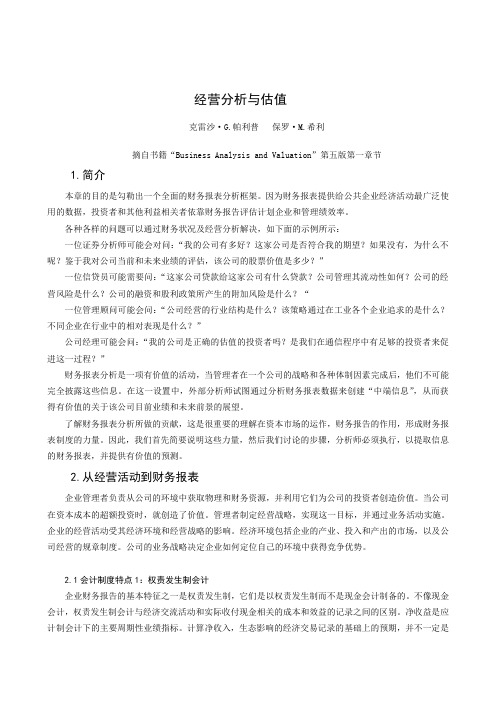
经营分析与估值克雷沙·G.帕利普保罗·M.希利摘自书籍“Business Analysis and Valuation”第五版第一章节1.简介本章的目的是勾勒出一个全面的财务报表分析框架。
因为财务报表提供给公共企业经济活动最广泛使用的数据,投资者和其他利益相关者依靠财务报告评估计划企业和管理绩效率。
各种各样的问题可以通过财务状况及经营分析解决,如下面的示例所示:一位证券分析师可能会对问:“我的公司有多好?这家公司是否符合我的期望?如果没有,为什么不呢?鉴于我对公司当前和未来业绩的评估,该公司的股票价值是多少?”一位信贷员可能需要问:“这家公司贷款给这家公司有什么贷款?公司管理其流动性如何?公司的经营风险是什么?公司的融资和股利政策所产生的附加风险是什么?“一位管理顾问可能会问:“公司经营的行业结构是什么?该策略通过在工业各个企业追求的是什么?不同企业在行业中的相对表现是什么?”公司经理可能会问:“我的公司是正确的估值的投资者吗?是我们在通信程序中有足够的投资者来促进这一过程?”财务报表分析是一项有价值的活动,当管理者在一个公司的战略和各种体制因素完成后,他们不可能完全披露这些信息。
在这一设置中,外部分析师试图通过分析财务报表数据来创建“中端信息”,从而获得有价值的关于该公司目前业绩和未来前景的展望。
了解财务报表分析所做的贡献,这是很重要的理解在资本市场的运作,财务报告的作用,形成财务报表制度的力量。
因此,我们首先简要说明这些力量,然后我们讨论的步骤,分析师必须执行,以提取信息的财务报表,并提供有价值的预测。
2.从经营活动到财务报表企业管理者负责从公司的环境中获取物理和财务资源,并利用它们为公司的投资者创造价值。
当公司在资本成本的超额投资时,就创造了价值。
管理者制定经营战略,实现这一目标,并通过业务活动实施。
企业的经营活动受其经济环境和经营战略的影响。
经济环境包括企业的产业、投入和产出的市场,以及公司经营的规章制度。
XXX分析框架与企业财务分析外文文献翻译

XXX分析框架与企业财务分析外文文献翻译XXX the use of the Harvard analysis XXX their internal and external environments。
XXX weaknesses。
and develop strategies for growth and success。
The article also examines the XXX of using the framework in financial analysis。
and provides examples of how it has been applied in us industries.nHarvard analysis XXX their internal and external XXX。
a renowned business strategist。
and is based on the XXX for growth and success。
The framework consists of five key components: the threat of new entrants。
the bargaining power of suppliers。
the bargaining power of buyers。
XXX substitute products or services。
and the XXX factors。
businesses XXX weaknesses。
as well as XXX.XXX of using the Harvard analysis framework in financial analysisOne of the main benefits of using the Harvard analysis framework in financial analysis is that it provides a XXX and weakness。
哈佛分析框架下的A公司财务分析
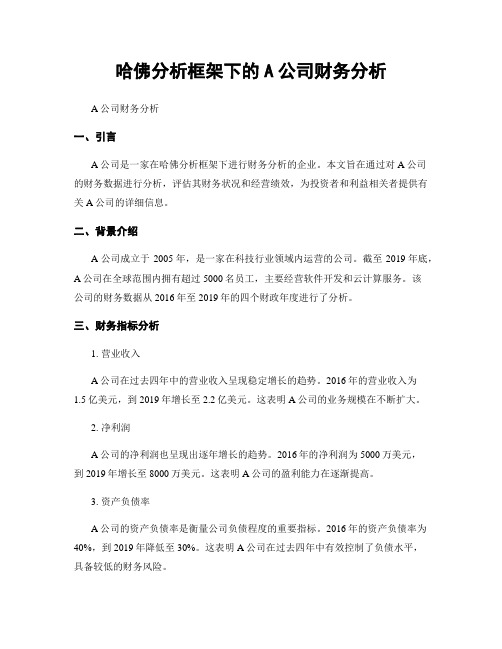
哈佛分析框架下的A公司财务分析A公司财务分析一、引言A公司是一家在哈佛分析框架下进行财务分析的企业。
本文旨在通过对A公司的财务数据进行分析,评估其财务状况和经营绩效,为投资者和利益相关者提供有关A公司的详细信息。
二、背景介绍A公司成立于2005年,是一家在科技行业领域内运营的公司。
截至2019年底,A公司在全球范围内拥有超过5000名员工,主要经营软件开发和云计算服务。
该公司的财务数据从2016年至2019年的四个财政年度进行了分析。
三、财务指标分析1. 营业收入A公司在过去四年中的营业收入呈现稳定增长的趋势。
2016年的营业收入为1.5亿美元,到2019年增长至2.2亿美元。
这表明A公司的业务规模在不断扩大。
2. 净利润A公司的净利润也呈现出逐年增长的趋势。
2016年的净利润为5000万美元,到2019年增长至8000万美元。
这表明A公司的盈利能力在逐渐提高。
3. 资产负债率A公司的资产负债率是衡量公司负债程度的重要指标。
2016年的资产负债率为40%,到2019年降低至30%。
这表明A公司在过去四年中有效控制了负债水平,具备较低的财务风险。
4. 现金流量A公司的现金流量状况良好。
从2016年到2019年,公司的经营活动现金流量逐年增加,表明公司的经营活动能够为其提供稳定的现金流入。
5. 偿债能力A公司的偿债能力较强。
以流动比率为例,2019年的流动比率为2.5,高于行业平均水平。
这表明A公司具备较强的偿债能力,能够及时偿还短期债务。
6. 盈利能力A公司的盈利能力稳定增长。
以净利润率为例,2019年的净利润率为15%,高于行业平均水平。
这表明A公司在行业中具备较高的盈利能力。
7. 投资回报率A公司的投资回报率逐年提高。
以资产回报率为例,2019年的资产回报率为10%,高于行业平均水平。
这表明A公司的资产运营效率不断提高。
四、风险分析1. 行业竞争A公司所处的科技行业竞争激烈,需要不断创新和投入研发。
《基于哈佛分析框架下的A公司财务分析研究》
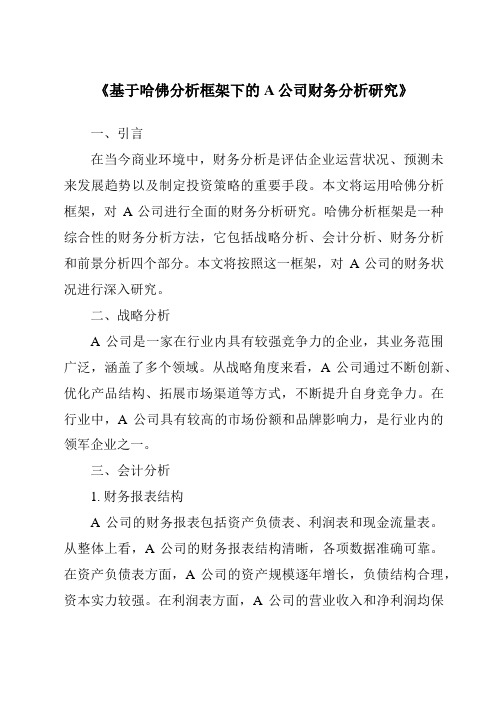
《基于哈佛分析框架下的A公司财务分析研究》一、引言在当今商业环境中,财务分析是评估企业运营状况、预测未来发展趋势以及制定投资策略的重要手段。
本文将运用哈佛分析框架,对A公司进行全面的财务分析研究。
哈佛分析框架是一种综合性的财务分析方法,它包括战略分析、会计分析、财务分析和前景分析四个部分。
本文将按照这一框架,对A公司的财务状况进行深入研究。
二、战略分析A公司是一家在行业内具有较强竞争力的企业,其业务范围广泛,涵盖了多个领域。
从战略角度来看,A公司通过不断创新、优化产品结构、拓展市场渠道等方式,不断提升自身竞争力。
在行业中,A公司具有较高的市场份额和品牌影响力,是行业内的领军企业之一。
三、会计分析1. 财务报表结构A公司的财务报表包括资产负债表、利润表和现金流量表。
从整体上看,A公司的财务报表结构清晰,各项数据准确可靠。
在资产负债表方面,A公司的资产规模逐年增长,负债结构合理,资本实力较强。
在利润表方面,A公司的营业收入和净利润均保持稳定增长,盈利能力较强。
在现金流量表方面,A公司的现金流入稳定,现金流充足。
2. 关键会计科目分析在关键会计科目方面,A公司的应收账款、存货、固定资产等科目的核算方法合理,能够真实反映公司的经营状况。
同时,A公司对会计政策的选择和变更也较为谨慎,保证了财务报表的可靠性。
四、财务分析1. 盈利能力分析A公司的盈利能力较强,营业收入和净利润均保持稳定增长。
通过利润率、资产收益率等指标的分析,可以看出A公司的盈利能力在行业中处于领先地位。
2. 运营能力分析A公司的运营能力较强,存货周转率、应收账款周转率等指标均处于行业领先水平。
这表明A公司具有较强的市场竞争力,能够快速响应市场需求,实现销售和回款。
3. 偿债能力分析A公司的偿债能力较强,资产负债率较低,流动比率和速动比率均处于合理水平。
这表明A公司具有较好的偿债能力和较低的财务风险。
五、前景分析基于五、前景分析基于哈佛分析框架,对A公司的前景进行分析,可以得出以下结论:1. 行业前景A公司所处的行业具有较好的发展前景。
《基于哈佛分析框架下的A公司财务分析研究》
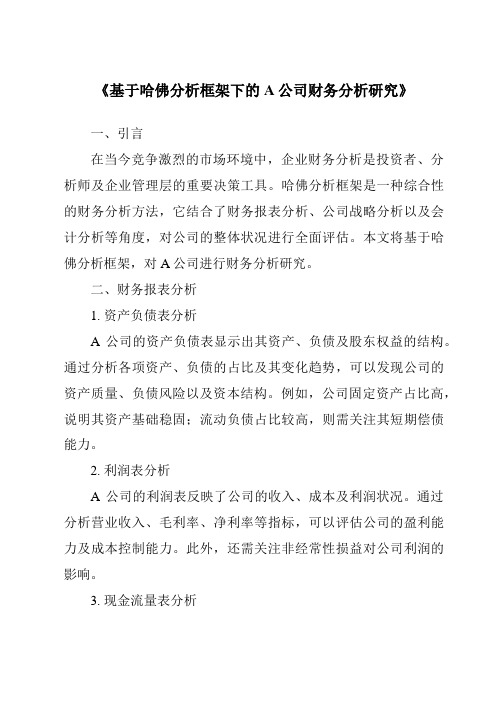
《基于哈佛分析框架下的A公司财务分析研究》一、引言在当今竞争激烈的市场环境中,企业财务分析是投资者、分析师及企业管理层的重要决策工具。
哈佛分析框架是一种综合性的财务分析方法,它结合了财务报表分析、公司战略分析以及会计分析等角度,对公司的整体状况进行全面评估。
本文将基于哈佛分析框架,对A公司进行财务分析研究。
二、财务报表分析1. 资产负债表分析A公司的资产负债表显示出其资产、负债及股东权益的结构。
通过分析各项资产、负债的占比及其变化趋势,可以发现公司的资产质量、负债风险以及资本结构。
例如,公司固定资产占比高,说明其资产基础稳固;流动负债占比较高,则需关注其短期偿债能力。
2. 利润表分析A公司的利润表反映了公司的收入、成本及利润状况。
通过分析营业收入、毛利率、净利率等指标,可以评估公司的盈利能力及成本控制能力。
此外,还需关注非经常性损益对公司利润的影响。
3. 现金流量表分析现金流量表体现了公司现金流入、流出及净流量的情况。
通过分析经营活动、投资活动、筹资活动的现金流量,可以评估公司的现金生成能力、资本支出及筹资需求。
三、公司战略分析1. 行业地位分析A公司在行业中的地位、市场份额、竞争优势等都会影响其财务状况。
通过分析公司的行业地位,可以了解其在行业中的竞争态势及未来发展趋势。
2. 业务类型与结构分析公司的业务类型与结构对其财务状况具有重要影响。
通过分析公司的业务类型、业务结构及其变化,可以了解公司如何通过业务调整来优化财务状况。
3. 战略目标与执行情况分析公司的战略目标与执行情况直接关系到其财务业绩。
通过分析公司的战略目标、执行措施及效果,可以评估公司战略的可行性与有效性。
四、会计分析1. 会计政策与估计的影响公司的会计政策与估计对其财务状况具有重要影响。
通过分析公司的会计政策、估计及其变更,可以了解公司如何通过会计手段来影响其财务数据。
2. 盈余管理问题探讨盈余管理是公司财务报表编制过程中的一种现象。
基于哈佛分析框架的BSY公司财务分析

基于哈佛分析框架的BSY公司财务分析【摘要】本文通过基于哈佛分析框架对BSY公司进行了财务分析。
在财务状况分析中,我们发现公司的资产负债表显示稳健的财务结构。
在盈利能力分析中,公司的利润表现稳定增长,但毛利率有所下降。
运营能力方面,公司的存货周转率较低,需要优化管理。
偿债能力方面,公司的偿债能力较强,但应注意长期债务比例。
现金流分析显示公司现金流量状况较好。
综合评价中,BSY公司整体表现良好,但需改善运营和存货管理。
未来发展建议包括提升营销力度和加强资产配置。
结论总结认为BSY公司在未来发展中应侧重提升存货周转率和长期财务规划。
【关键词】BSY公司、财务分析、哈佛分析框架、研究背景、研究目的、财务状况、盈利能力、运营能力、偿债能力、现金流、财务表现、发展建议、结论。
1. 引言1.1 研究背景BSY公司是一家知名的跨国企业,总部位于美国。
自成立以来,BSY 公司一直致力于提供高品质的产品和服务,赢得了广泛的市场认可和客户信赖。
随着全球经济的不断发展和竞争的加剧,企业面临着越来越多的挑战和机遇。
财务分析作为评估企业经营状况和未来发展方向的重要工具,对于BSY公司的持续成功至关重要。
在当今复杂多变的商业环境下,BSY公司需要及时了解自身的财务状况,及时调整经营策略,保持竞争优势。
对BSY公司的财务状况进行深入分析,可以帮助企业更好地应对风险和挑战,把握市场机遇,实现可持续发展。
通过本次基于哈佛分析框架的财务分析,旨在全面了解BSY公司的财务表现,为企业制定未来发展战略提供参考依据。
述是本文即将介绍的内容,为读者提供了对本次分析的背景和意义。
1.2 研究目的本文旨在通过基于哈佛分析框架对BSY公司的财务状况进行深入分析,以揭示该公司在财务领域的优势和劣势。
通过对BSY公司的盈利能力、运营能力、偿债能力和现金流状况进行综合评估,旨在为投资者、管理层和其他利益相关方提供有益的参考信息。
具体目的包括:1. 分析BSY公司的财务状况,了解其资产负债结构、财务稳定性和资金运作情况。
基于哈佛分析框架下的企业财务分析

基于哈佛分析框架下的企业财务分析一、引言企业财务分析是指通过对企业财务数据的采集、整理和分析,对企业的财务状况和经营绩效进行评估和预测的过程。
哈佛分析框架是一种常用的分析方法,它包括了五个方面的内容:财务状况、盈利能力、运营能力、成长能力和风险管理。
本文将基于哈佛分析框架,对某企业的财务数据进行分析,以匡助读者更好地了解企业的财务状况和经营绩效。
二、财务状况分析财务状况是企业财务健康的基础,主要通过财务报表中的资产负债表进行分析。
在资产负债表中,我们可以看到企业的资产、负债和所有者权益等信息。
通过计算企业的负债率、资产负债比率和流动比率等指标,我们可以评估企业的偿债能力和流动性状况。
例如,某企业的负债率为40%,资产负债比率为60%,流动比率为1.5,说明企业的偿债能力较好,流动性较强。
三、盈利能力分析盈利能力是企业经营业绩的重要指标,主要通过利润表进行分析。
在利润表中,我们可以看到企业的营业收入、净利润、毛利率和净利率等信息。
通过计算企业的毛利率和净利率,我们可以评估企业的盈利能力。
例如,某企业的毛利率为30%,净利率为10%,说明企业在销售产品或者提供服务时能够保持较高的利润水平。
四、运营能力分析运营能力是企业实现盈利能力的基础,主要通过利润表和现金流量表进行分析。
在利润表中,我们可以看到企业的销售成本、销售费用和管理费用等信息。
通过计算企业的销售毛利率和销售净利率,我们可以评估企业的运营能力。
在现金流量表中,我们可以看到企业的经营活动现金流量,通过计算经营活动现金流量比率,我们可以评估企业的现金流状况。
例如,某企业的销售毛利率为20%,销售净利率为8%,经营活动现金流量比率为1.2,说明企业在运营方面表现较好。
五、成长能力分析成长能力是企业发展的关键,主要通过利润表和现金流量表进行分析。
在利润表中,我们可以看到企业的营业收入和净利润的年度变化情况。
通过计算企业的营业收入增长率和净利润增长率,我们可以评估企业的成长能力。
《基于哈佛分析框架的房地产公司财务研究国内外文献综述5100字》

基于哈佛分析框架的房地产公司财务研究国内外文献综述1 国外研究现状(1)关于房地产公司经营发展的研究国外关于房地产公司经营发展的研究较早,尤其是21世纪以后,相关的研究很多,Michael Ramorio(2017)研究发达国家和发展国家的不同,发达国家的房地产公司更注重建立良好的品牌形象、提升产品质量和防范资金风险,而发展中国家则更注重房地产销售这个环节,因此对影响房地产行业价格波动的政策更关注[1]。
Yontz,William L(2020)在对印度尼西亚的房地产公司发展战略的研究中,得到了发展战略需要根据外界环境的变化、企业内业务的调整和财务状况这三者共同来确定[2]。
Peter MK ,Kraft C(2020)对澳大利亚国内排名前10的房地产公司进行研究,发现实力强的房地产公司更应该积极地采用全球化战略去开拓国外市场,才是最有利于企业发展的[3]。
Ngoc N M , Tien N H(2021)根据成本模型建立了一体化战略模型同样得出了房地产公司的发展战略制定需要优先考虑其业务活动的调整[4]。
(2)关于财务分析的研究Khoja L, Chipulu M, Jayasekera R(2019)认为,在分析企业财务状况时,必须结合宏观环境和行业发展前景等非财务信息,才能全面、准确了解企业经营状况,降低经营风险[5]。
Michael H.David L和John D(2020)认为财务分析是一项非常丰富的工具,但目前缺乏适用于所有企业的分析指标。
因此提出用距离度量指标来解释股权收益、企业债券评级和企业困境的总体风险和系统性风险,并说明了大数据应用在财务分析中可以发挥的优势[6]。
Martin Fridson(2010)重点研究了股票价值分析以及并购估值的财务分析框架,指出企业的经营环境受国内外政经济环境的影响。
在财务分析框架有对外部环境信息的详细分析,可以有效地增强财务预测的准确性[7]。
基于哈佛框架杜邦分析的财务综合分析--以雅居乐地产为例
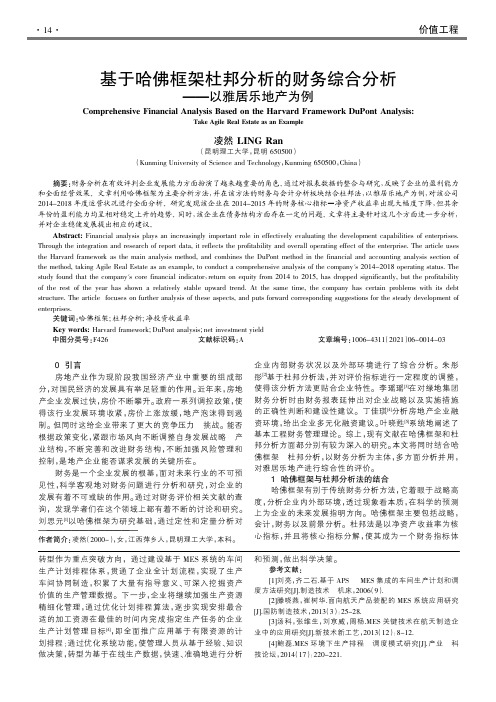
价值工程基于哈佛框架杜邦分析的财务综合分析———以雅居乐地产为例Comprehensive Financial Analysis Based on the Harvard Framework DuPont Analysis:Take Agile Real Estate as an Example凌然LING Ran(昆明理工大学,昆明650500)(Kunming University of Science and Technology,Kunming650500,China)摘要:财务分析在有效评判企业发展能力方面扮演了越来越重要的角色。
通过对报表数据的整合与研究,反映了企业的盈利能力和全面经营效果。
文章利用哈佛框架为主要分析方法,并在该方法的财务与会计分析板块结合杜邦法,以雅居乐地产为例,对该公司2014-2018年度运营状况进行全面分析。
研究发现该企业在2014-2015年的财务核心指标—净资产收益率出现大幅度下降,但其余年份的盈利能力均呈相对稳定上升的趋势。
同时,该企业在债务结构方面存在一定的问题。
文章将主要针对这几个方面进一步分析,并对企业稳健发展提出相应的建议。
Abstract:Financial analysis plays an increasingly important role in effectively evaluating the development capabilities of enterprises. Through the integration and research of report data,it reflects the profitability and overall operating effect of the enterprise.The article uses the Harvard framework as the main analysis method,and combines the DuPont method in the financial and accounting analysis section of the method,taking Agile Real Estate as an example,to conduct a comprehensive analysis of the company's2014-2018operating status.The study found that the company's core financial indicator,return on equity from2014to2015,has dropped significantly,but the profitability of the rest of the year has shown a relatively stable upward trend.At the same time,the company has certain problems with its debt structure.The article focuses on further analysis of these aspects,and puts forward corresponding suggestions for the steady development of enterprises.关键词:哈佛框架;杜邦分析;净投资收益率Key words:Harvard framework;DuPont analysis;net investment yield中图分类号:F426文献标识码:A文章编号:1006-4311(2021)06-0014-03———————————————————————作者简介:凌然(2000-),女,江西萍乡人,昆明理工大学,本科。
基于哈佛分析框架下的企业财务分析

基于哈佛分析框架下的企业财务分析陈明伟鲁银投资集团股份有限公司摘要:在企业财务分析方面充分应用哈佛分析框架,可以对企业经营发展过程中的财务风险以及发展前景进行更准确的判断分析。
本文针对哈佛分析框架在企业内部的应用,首先介绍了传统财务分析方法存在的问题,进而介绍了哈佛分析框架的主要优势,最后就哈佛分析框架在企业内部的应用,进行了详细论述。
关键词:哈佛分析框架;财务分析;应用策略基于哈佛分析框架进行企业的财务分析,可以通过在财务分析中引入战略分析、前景分析、会计分析以及财务分析等,从战略的角度对企业进行相应的财务分析,改变以往财务分析模式下财务分析主要是以财务报表数据为主的定量分析,进而提高财务分析预测的科学性。
对于企业来说,在内部财务管理方面,应该深入研究分析哈佛分析框架的具体应用策略,提高哈佛分析框架下的企业财务分析水平,提高对企业筹资、投资以及经营活动分析评价的准确性,进而为企业的经营管理决策提供更加准确的信息数据支持。
一、传统财务分析存在的主要问题分析传统的财务分析主要是以企业的财务报表作为基本的数据来源,通过采取不同的计算以及组合方式来得到不同的比较数据,对财务数据指标之间的关联来进行比较分析,对企业的财务状况进行预测。
传统的财务分析方法主要是由趋势分析法、比率分析法、结构分析法以及因子分析法,在传统的财务报表分析内容上主要是有偿债能力分析、营运能力分析、盈利能力分析以及发展能力分析。
传统财务分析的缺陷主要有以下几方面:首先,传统财务分析重视财务信息的分析而对非财务信息有所忽略,但是由于财务信息在展现形式上主要是作为历史数据的形式展现,因而主要是表征的企业一段时间内的经营成果,而对其中的非财务信息,尤其是财务报表附注中的有关非财务信息往往有所忽略,因而对于其中隐含的影响企业决策计划的内容分析不够。
其次,传统的财务分析更加重视的是对企业财务状况以及经营成果的分析,而对于企业所面临的风险以及经营的不确定性分析不够,特别是当前随着市场经济环境下各类衍生金融工具的不断增加以及金融产品升级周期的缩短,企业经营发展所面临的外部风险以及经营不确定性越来越多,如果只重视财务状况以及经营成果,对于企业的财务风险分析可能出现错判。
《哈佛分析框架下的企业财务分析国内外文献综述3500字》

哈佛分析框架下的企业财务分析国内外文献综述(二)国内外研究成果综述1.国内研究成果与国际比较,我们国内财务分析研究开始得晚,财务报表分析的水平也有些滞后。
但是后来由于我国学者不断得深入研究,逐渐丰富了我国财务分析方法。
张先治教授在上个世纪90年代,通过对我国的财务分析现状进行了系统的整理与研究,于1995年完成了对我国的财务分析理论的分类与定位。
在他的观点中,会计与基于会计的财务分析并不是一样的,虽然有着一定的联系,但本质上存在着很多的差异,并且张教授对这些差异一一做出了解释以及区分。
2001年教授通过对美国财务分析情况的研究与探索,对我过的财务分析体系做出了重建。
1樊行健(2005)提出,我国的会计分析一直都不怎么被大家所重视,与西方国家相比,明显存在较大的差距。
会计工作只能反映公司经济活动的原始数据信息。
因此,重点要将财务跟经济活动结合起来,并要考虑到成本分析在里面所起到的作用。
2陈如意(2006)撰写了一篇有关现行财务报表分析的文章。
文中的观点为,我国的当前基于财务报表的分析方法,有着很多弱项和空缺,其中也包括了在实际操作中的一些限制和信息披露方面的漏洞。
3黄世忠(2007)进行了案例研究。
他经过案例研究,探索出对财务分析有着重要的关键因素,分别为资产质量、现金流量情况和盈利质量这几个关键要素。
并对西方学着的理论研究成果进行了概述。
本书就财务表要素与现金流量的关系以及相关问题进行了结合实践。
4胡玉明(2007) 提出传统财务报表分析具有一定的局限,企业财务报表只是记载一些企业过去实际发生过的事情,这就使得企业财务报表会以结果导向作为起点。
就其本身而言,大家没办法明白“之所以产生这样结果”的来龙去脉,分析和使用企业财务报表的人只能够“知其然,却不知其所以然”。
他认为,企业财务报表分析的基本思维一定要从企业经营的环境和经营策略出发,在企业经营活动中反观企业财务报表,在公司财务报表中分析企业经营活动,然后对企业财务报表分析的主要框架进行构想。
基于哈佛分析框架的BSY公司财务分析
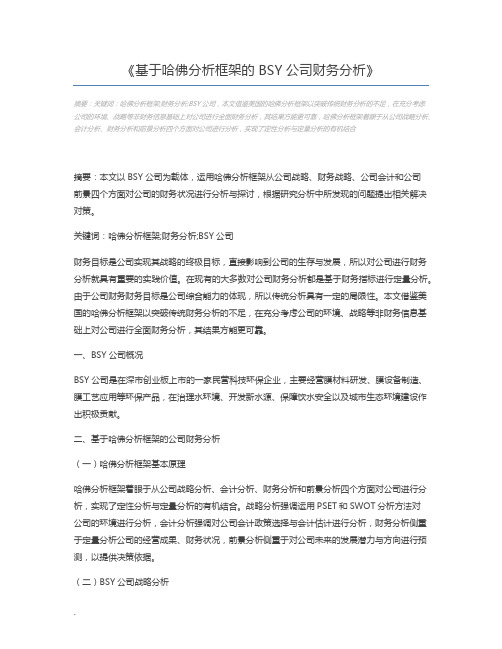
《基于哈佛分析框架的BSY公司财务分析》摘要:关键词:哈佛分析框架;财务分析;BSY公司,本文借鉴美国的哈佛分析框架以突破传统财务分析的不足,在充分考虑公司的环境、战略等非财务信息基础上对公司进行全面财务分析,其结果方能更可靠,哈佛分析框架着眼于从公司战略分析、会计分析、财务分析和前景分析四个方面对公司进行分析,实现了定性分析与定量分析的有机结合摘要:本文以BSY公司为载体,运用哈佛分析框架从公司战略、财务战略、公司会计和公司前景四个方面对公司的财务状况进行分析与探讨,根据研究分析中所发现的问题提出相关解决对策。
关键词:哈佛分析框架;财务分析;BSY公司财务目标是公司实现其战略的终极目标,直接影响到公司的生存与发展,所以对公司进行财务分析就具有重要的实践价值。
在现有的大多数对公司财务分析都是基于财务指标进行定量分析。
由于公司财务财务目标是公司综合能力的体现,所以传统分析具有一定的局限性。
本文借鉴美国的哈佛分析框架以突破传统财务分析的不足,在充分考虑公司的环境、战略等非财务信息基础上对公司进行全面财务分析,其结果方能更可靠。
一、BSY公司概况BSY公司是在深市创业板上市的一家民营科技环保企业,主要经营膜材料研发、膜设备制造、膜工艺应用等环保产品,在治理水环境、开发新水源、保障饮水安全以及城市生态环境建设作出积极贡献。
二、基于哈佛分析框架的公司财务分析(一)哈佛分析框架基本原理哈佛分析框架着眼于从公司战略分析、会计分析、财务分析和前景分析四个方面对公司进行分析,实现了定性分析与定量分析的有机结合。
战略分析强调运用PSET和SWOT分析方法对公司的环境进行分析,会计分析强调对公司会计政策选择与会计估计进行分析,财务分析侧重于定量分析公司的经营成果、财务状况,前景分析侧重于对公司未来的发展潜力与方向进行预测,以提供决策依据。
(二)BSY公司战略分析1.基于PEST分析方法的公司宏观环境分析PEST是指从政治环境P、经济环境E、社会环境S和技术环境T四个方面分析公司的宏观环境状况。
- 1、下载文档前请自行甄别文档内容的完整性,平台不提供额外的编辑、内容补充、找答案等附加服务。
- 2、"仅部分预览"的文档,不可在线预览部分如存在完整性等问题,可反馈申请退款(可完整预览的文档不适用该条件!)。
- 3、如文档侵犯您的权益,请联系客服反馈,我们会尽快为您处理(人工客服工作时间:9:00-18:30)。
毕业设计附件外文文献翻译:原文+译文文献出处:Andrew G. The study of Harvard analysis framework and corporate financial analysis. American Journal of sociology, 2016, 2(4): 283-301.原文The study of Harvard analysis framework and corporate financial analysisAndrew GAbstractAn effective financial analysis framework should not only learn how to use accounting data, and be good at using the accounting data. Enterprises to implement its business strategy are based on the accounting data, and ignore the enterprise environment and strategic analysis. Thus, to a more comprehensive understanding of enterprise operating performance, but also extends the traditional financial analysis object by the financial statements for the entire financial report and related institutional environment, build a new financial analysis framework is more and more necessary.New analysis framework should be more with strategic vision, focus on the development strategy of the enterprise, takes the enterprise's competitive position, USES the method of management related problem analysis, financial statement analysis and analysis of organic combination of enterprise development strategy, analysis of enterprise internal and external management environment, combined with the overall development of the enterprise strategic and long-term interests, analyze the content of the more widely and more wide, to the enterprise management decision making will be more valuable. Harvard analysis framework and harvard analysis framework arises at the historic moment, standing in a strategic point of view, is not limited to the company's financial statements, to analyze the opportunities and threats from external environment, and the enterprise internal strengths and weaknesses, the analysis of financial situation improved prediction is scientific, pointed out the direction of future development for the enterprise.Keywords: Harvard analysis framework, the electric power enterprise, strategy, financial analysis1 IntroductionThe development needs of an enterprise financial analysis for its help, financial analysis has attracted the attention of the enterprise, experts and scholars are also constantly explore the solution to the financial analysis, financial analysis framework of research in recent years, more and more. Harvard analysis is the sublimation of traditional financial analysis, the framework from the management strategy of enterprises, analyzes the financial data of the enterprise, accounting analysis, find out enterprise possible false results, and then adopt some methods to improve the quality of accounting information, and on the basis of financial analysis, realistic analysis of the results, and then forecast the prospect of the enterprise. The traditional financial analysis framework is in the long-term practice of financial analysis and theoretical summary and form, it is main analysis object with financial statements, although joined the financial comprehensive analysis model or system, but still with quantitative analysis as the basic characteristics of neglect or some important financial information cannot be effectively incorporated into the analysis framework. Traditional analysis framework is mainly analysis enterprise's financial statements, is basically a state of "report on report". And commonly used analysis methods mainly include ratio analysis, comparative analysis, trend analysis and DuPont financial analysis system, etc., mainly through the calculation and comparison of the financial statement data, draw the corresponding index data, then the results of comparative analysis and factor analysis, heavy "quantity" is not "quality", the lack of the nature of the analysis of a problem. Traditional analysis, with emphasis on the internal situation, the main process flows of the enterprise, asset utilization ability, debt paying ability, profitability analysis, and ignore the external business environment. And analysis based on financial statements and financial statements is a summary of the business in the past, and this analysis has the obvious lag. The traditional financial analysis framework to analyze the data on the enterprise accounting statements cannot havesatisfied the needs of the development of enterprises now.2 Literature reviewCommon methods of financial analysis can be summarized as three kinds: DuPont financial analysis method, economic value added and balanced scorecard method. DuPont financial analysis method the enterprise net assets yield level decomposition to the product of a number of financial ratios, by using the inner relationship between financial indicators, comprehensive management of the enterprise financial management system and the economic benefit of this evaluation. It can help enterprise management more clearly see the determinants of return on net assets, and the sales net profit margin and total asset turnover, the correlation relationship between the debt ratio, provides a clear overview to management whether the company assets management efficiency and maximize shareholder returns roadmap. Economic value added theory init ially by Merton miller and Franco’s dial, two famous economists put forward. Later in the United States, tang, consulting company realized that this method is to evaluate the value of the company a good method, so the company will set up the method to promote worldwide. Economic value added is the company's operating profit after tax and the difference between the costs of capital; it takes into account the opportunity cost of capital economic profits, rather than accounting profit. It will force the company decision-makers high attention to the cost of capital. Put forward by Robert Kaplan, the balanced scorecard, which is based on enterprise strategy as the guidance, through finance, customer, operations and staff from four aspects and performance indicators of cause and effect, comprehensive management and the enterprise integrated performance evaluation system. Because of its advanced and has a certain reliability, so has been the favor of some companies. This kind of evaluation method to evaluate the quality of people to have certain request, because the choice of evaluation index need to refer to the company all aspects of characteristics, in order to fully reflect the company's financial position and operating results.In this increasingly mature, on the basis of financial analysis methods, scholars began to pay attention to these methods can be incorporated into a complete financialanalysis system, in order to form a frame structure, support for the enterprise economic operation.ErichHelford analysis framework is divided into introduction, operation analysis, investment analysis, financing analysis, value analysis several part. Summarizes the enterprise system, decision background and its relationship with financial statements and analysis tools, discussed including investment analysis, capital cost and financing options, and stock and enterprise value assessment, etc.Elisha based on the traditional financial analysis framework, which based on the analysis of enterprise debt paying ability, assets operation ability, profit ability and development ability, added into some of the industry analysis and the analysis of competition strategy. It includes business strategy analysis, accounting analysis, financial statement analysis and prospect analysis of four parts.The main points of the frame is in the business strategy analysis under the premise of accounting analysis, financial analysis and prospect analysis, shows that it is in a macro view more open order detail analysis, not only do detail analysis. Clyde P to financial analysis framework is divided into three parts, the first part of the financial accounting environment, the analysis of the data and the relationship between the enterprises the main activities, etc;The second part of accounting analysis, from the generally accepted accounting principles, analysis the connotation of the accounting item and quality; The third part of financial analysis, namely from the profitability, risk, prediction and evaluation of enterprise financial position and operating results are analyzed.3 Harvard theory analysis frameworks3.1 Strategic analysisStrategic analysis is the logical starting point of financial statement analysis, is also a Harvard analysis framework and other different parts of the financial analysis. Financial statement analysis is through the strategy analysis to the business activities of enterprises qualitative analysis of its economic significance, but also to accounting analysis and financial analysis for providing realistic background. Its main from the industry analysis and competitive strategy analysis of the two sides is analyzed. Can make use of porter five analysis, industry analysis to analyze the profitability of theindustry, by analyzing the existing and potential competitiveness, and negotiation ability, in the buying and selling market for investors to the data analysis of the industry has an overall grasp. Through the analysis of the industry development stage, the industry technological change speed, the product difference and integration, the buyer the seller number and relative size, industry market boundaries, total market and growth prospects, such as analysis, can see the nature of the industry and its status and role in the national economy. Sometimes, according to the characteristics of different industry life cycle for analysis. Must analysis the enterprise competition strategy analysis the characteristics of the industry and competitiveness problems. Choose attractive strong industry is part of business success, however, the real key to the success or failure of the enterprise is the enterprise the selected cost leadership strategy or differentiation strategy enforcement of whether to make a difference. Cost advantages including at a lower cost to provide the same product or service ability, a large number of mass production scale, production efficiency, etc.Difference advantage to supply a unique product or service cost is lower than the price, consumers preferred to buy a better product quality, more product variety, better customer service, etc.3.2 Accounting analysisAccounting analysis aims to evaluate financial statement disclosure of accounting information to the enterprise actual reflect the degree of operating conditions. Through the evaluation of enterprise accounting policies and accounting estimates whether appropriate, can assess the enterprise accounting information distortion degree. Through the analysis of the notes to financial statements, understand accounting statements behind digital detailed composition and not reflected in the information on accounting statements, by analyzing industry transverse and longitudinal analysis of the enterprise financial data that may exist in the water, and then to certain adjustment of financial data, and according to the adjusted data to the financial statements, so that they can more accurately grasp the enterprise the management condition. Accounting analysis steps in turn have to identify the key accounting policies, evaluating accounting flexibility, evaluationstrategy, accounting disclosure quality evaluation, recognize danger signals and finally eliminate the distortion of accounting information. Accounting analysis method can have the audit report to analysis, abnormal profit excluding method, cash flow analysis, related party transactions rejecting method eliminating method and the virtual assets.3.3 Financial analysisThe main content of financial analysis is to enterprise's debt paying ability, operation ability, and profit ability; create cash flow capacity using the method of financial ratio analysis and cash flow analysis to analysis and research. Is the purpose of financial analysis using the financial data to evaluate the performance of enterprise at present and the past, in order to better know and enterprise strategy is linked to performance. Ratio analysis is mainly used to evaluate the enterprise product market performance and financial policy. Cash flow analysis is mainly used to evaluate enterprise asset liquidity and financial flexibility. Analyze the corporate profitability and growth is one of the major problems of financial statement analysis and evaluation. Through the analysis of the problem can be used to develop product strategy and financial strategies. Product strategy, operation and management, including analysis of revenues and expenses management, working capital and the management of fixed assets investment management. Management of finance strategy including the analysis of debt and equity structure of financing strategy, dividend payments and profit distribution of dividend policy. Conduct financial analysis and accounting information distortion phenomenon is more common, so the Harvard analysis under the framework of financial analysis are not independent accounting data, but according to the result of step in the accounting analysis, namely the financial statements of the enterprise artificial out financial analysis, and the related parameters of the accounting statements and peer enterprises horizontal comparison, and analysis enterprise's position in the industry and its realistic situation.译文哈佛分析框架与企业财务分析研究Andrew G摘要一个有效地财务分析框架不仅要学习如何使用会计数据,而且要善于运用非会计数据。
